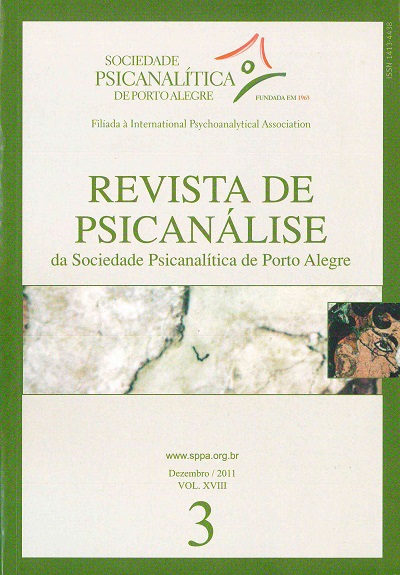O fenômeno bullying na adolescência
Palavras-chave:
Bullying, Adolescência, ViolênciaResumo
O fenômeno bullying é um dos sintomas mais preocupantes na escola e na sociedade hoje, representando uma manifestação de violência na adolescência, com origens multifatoriais, no qual interagem de forma complexa fatores individuais, familiares e sociais. A partir de uma revisão do tema, a autora discute aspectos relacionados ao processo da adolescência e a alguns fatores associados ao comportamento agressivo (AU)
Downloads
Referências
AKIBA, M. et al. (2002). Student victimization: national and school system effects on school
violence in 37 nations. Am. Educ. Res J., v. 39, p. 829-853.
AMERICAN ACADEMY OF CHILD AND ADOLESCENT PSYCHIATRY. Understanding violent
behavior in children and adolescents. Facts for Families. n. 55. Acesso em 14/05/2011. Disponível
em: < www.aacap.org/publications/factsfam/behavior.htm >.
ASSOCIAÇÃO BRASILEIRA MULTIPROFISSIONAL DE PROTEÇÃO À INFÂNCIA E À
ADOLESCÊNCIA. Programa de redução do comportamento agressivo entre estudantes. Rio de
Janeiro: ABRAPIA, 2002.
BERGER, K. (2007). Update on bullying at school: science forgotten? Developmental Review, v.
, p. 90-126.
BLOS, P. (1962). On adolescence: a psychoanalytic interpretation. New York: Free.
BORG, M. (1999). The extent and nature of bullying among primary and secondary schoolchildren.
Educational Research, n. 41, n. 2, p. 137-153.
CENTRO de empreendedorismo social e administração em terceiro setor. Fundação Instituto de
Administração. Relatório de pesquisa: Bullying escolar no Brasil. São Paulo: CEATS/FIA, mar./
CAHN, R. (2009). Abordagem metapsicológica da adolescência de hoje. Revista de Psicanálise
da Sociedade Psicanalítica de Porto Alegre. v. 15, n. 2, p. 299-312.
DAWKINS, J. (1995). Bullying in school: doctor’s responsibilities. BMJ, 310, p. 274-275.
FANTE, C. (2005). Fenômeno bullying: como prevenir a violência nas escolas e educar para a
paz. Campinas: Verus.
FANTE, C.; PEDRA, J. A. (2008). Bullying escolar: perguntas e respostas. Porto Alegre: Artmed.
FEKKES, M.; PIIPERS, F.I., VERLOOVE-VANHORICK, S. P. (2005). Bullying: who does what,
when and where? Involvement of children, teachers and parents in bullying behavior. Health Educ.
Res., v. 20, p. 81-91.
FONAGY, P. (1999). Male perpetrators of violence against women: an attachment theory
perspective. J. Allied Psychoanal. Studies, v. 1, n. 1, p. 7-27.
FONSECA, S.; MOLEIRO, C.; SALES, C. (2009). Violence in portuguese schools. National Report. Int. J. Violence and School, v. 9, p. 57-78.
LAMB, J.; PEPLER, D.; CRAIG, W. (2009). Approach to bullying and victimization. Canadian
Family Physician, v. 55, n. 4, p. 356-360.
LEVY, R. (2001). O adolescente. In: EIZIRIK, C.; KAPCZINSKY, F.; BASSOLS, A. M. O ciclo
da vida humana: uma perspectiva psicodinâmica. Porto Alegre: Artmed, p. 127-140.
LOPES NETO, A. A.; SAAVEDRA, L. H. (2004). Diga não para o bullying. Rio de Janeiro:
ABRAPIA.
LOPES NETO, A. A. (2005). Bullying: comportamento agressivo entre estudantes. Jornal de
Pediatria. n. 81, (5 Supl.), p. 164-172.
______.(2006). Adolescência: o reordenamento simbólico, o olhar e o equilíbrio narcísico. Revista
de Psicanálise da SPPA, v.13, n. 2, p. 233-254.
______. (2007). Bullying. Adolesc. Saúde. v. 4, n. 3, p. 51-56.
MAIN, M.; KAPLAN, N.; CASSIDY, J. (1985). Security in infancy, childhood and adulthood.
Monograph for the Society for Research in Child Devel., 50 (1- 2, Serial n. 209), p. 66-104.
MELTZER, D. (1978). Seminários de Novara: teoria psicanalítica da adolescência. Traduzido de
Quaderni di Psicoterapia Infantile. Roma: Borla.
NIN, A. (2006). Jogos de vida e jogos de morte na adolescência. Revista de Psicanálise da SPPA,
v. 13, n. 2, p. 259-271.
OLWEUS, D. (1993). Bullying at school: what we know and what we can do. Oxford: Blackwell.
PIZARRO, H. C.; JIMÉNEZ, M. I. (2007). Maltrato entre iguales en la escuela costaricense. Revista Educación, v. 31, n. 1, p. 135-144.
POLMEAR, C. (2004). Dying to live: mourning, melancholia and the adolescent process. J. Child Psychotherapy, v. 30, n. 3, p. 263-274.
RAMÍREZ, F. C. (2001). Variables de personalidad asociadas en la dinámica bullying (agresores
versus víctimas) en niños y niñas de 10 a 15 años. Anales de Psicología, v. 17, n. 1, 37-43.
REMSCHMIDT, H. et al. (2007). The mental health of children and adolescents: an area of global neglect. New Jersey: John Wiley & Sons.
RODRÍGUEZ, N. (2007). Bullying, guerra na escola. Lisboa: Sinais de Fogo.
SEIXAS, S. R. (2009). Diferentes olhares sobre o fenômeno bullying em contexto escolar. Interações, n. 13, p. 1-9.
SILVA, A. B. B. (2010). Bullying: mentes perigosas nas escolas. Rio de Janeiro: Objetiva.
SMITH, J.; TWEMLOW, S. W.; HOOVER, D. W. (1999). Bullies, victims and bystanders: a method
of in-school intervention and possible parental contributions. Child Psychiat. & Human Devel., v. 30, n. 1, p. 29-37.
STROZIER, C. B. Youth violence and the apocalyptic. Amer. J. Psychoanalysis, v. 62, n. 3, p. 285-298.
TWEMLOW, S.W. FONAGY, P., SACCO, F. C., GIES, M. L., EVANS, R., EWBANK, R. (2001). Creating a peaceful school learning environment: a controlled study of an elementary school intervention to reduce violence. Amer. J. Psychiatry, v. 158, p. 808-810.
TWEMLOW. S. W. (2003). A crucible for murder: the social context of violent children and adolescents. Psychoanalitic Quarterly, v. 72, p.659-98.
ZOTTIS, G. A. H.; ISOLAN, L; SALUM, G. A.; TOCCHETTO, A.; MANFRO, G. G.; HELDT, E. (2010). Prevalência de bullying em escolas da rede estadual de Porto Alegre-RS. Rev. HCPA, v. 30
(Supl.) p. 226.
Downloads
Publicado
Como Citar
Edição
Seção
Licença
Atribuo os direitos autorais que pertencem a mim, sobre o presente trabalho, à SPPA, que poderá utilizá-lo e publicá-lo pelos meios que julgar apropriados, inclusive na Internet ou em qualquer outro processamento de computador.
I attribute the copyrights that belong to me, on this work, to SPPA, which may use and publish it by the means it deems appropriate, including on the Internet or in any other computer processing.
Atribuyo los derechos de autor que me pertenecen, sobre este trabajo, a SPPA, que podrá utilizarlo y publicarlo por los medios que considere oportunos, incluso en Internet o en cualquier otro tratamiento informático.










